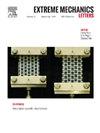Effect of extreme hydrostatic pressure on ion diffusion in polymer electrolytes: Emergence of glass-transition pressure
IF 4.5
3区 工程技术
Q2 MATERIALS SCIENCE, MULTIDISCIPLINARY
引用次数: 0
Abstract
Polymer electrolytes in solid-state batteries are critical for applications demanding mechanical flexibility and tolerance. Recent research progress has underscored the potential significance of employing solid electrolytes in extreme environments, such as the high hydrostatic pressure encountered during deep-sea exploration. Consequently, understanding how extreme hydrostatic pressure affects ion diffusion in polymer electrolytes is of substantial importance. In this work, large-scale molecular dynamics simulations are utilized to investigate the diffusion of lithium bis(trifluoromethanesulfonyl)imide (LiTFSI) in a representative polymer electrolyte, specifically poly(ethylene oxide) (PEO). We reveal a previously unreported mechanism associated with the emergence of a glass-transition pressure, above which the polymer matrix exhibits glass-like characteristics. The transport behavior of Li⁺ ions shows a distinct contrast below and beyond this critical pressure. Through theoretical scaling analysis, we show that ionic diffusivity is proportional to material volume, and is therefore governed by this same phase-transition pressure, which rationalizes our simulation results. This work provides potential guidance for understanding and designing polymer electrolytes with tolerance to extreme pressures.
极端静水压力对聚合物电解质中离子扩散的影响:玻璃化转变压力的出现
固态电池中的聚合物电解质对于要求机械灵活性和耐受性的应用至关重要。最近的研究进展强调了在极端环境中使用固体电解质的潜在意义,例如在深海勘探期间遇到的高静水压力。因此,了解极端静水压力如何影响聚合物电解质中的离子扩散是非常重要的。在这项工作中,利用大规模分子动力学模拟来研究锂二(三氟甲烷磺酰)亚胺(LiTFSI)在典型聚合物电解质,特别是聚环氧乙烷(PEO)中的扩散。我们揭示了先前未报道的与玻璃化转变压力出现相关的机制,高于此压力的聚合物基质表现出玻璃样特征。Li +离子的输运行为在这个临界压力以下和超出这个临界压力之后显示出明显的对比。通过理论尺度分析,我们发现离子扩散率与材料体积成正比,因此受相同的相变压力的控制,这使我们的模拟结果合理化。这项工作为理解和设计耐极端压力的聚合物电解质提供了潜在的指导。
本文章由计算机程序翻译,如有差异,请以英文原文为准。
求助全文
约1分钟内获得全文
求助全文
来源期刊

Extreme Mechanics Letters
Engineering-Mechanics of Materials
CiteScore
9.20
自引率
4.30%
发文量
179
审稿时长
45 days
期刊介绍:
Extreme Mechanics Letters (EML) enables rapid communication of research that highlights the role of mechanics in multi-disciplinary areas across materials science, physics, chemistry, biology, medicine and engineering. Emphasis is on the impact, depth and originality of new concepts, methods and observations at the forefront of applied sciences.
 求助内容:
求助内容: 应助结果提醒方式:
应助结果提醒方式:


